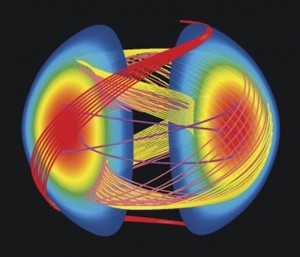
Oxygen ‘sponge’ may lead to improved catalysts, energy materials
Scientists at the US Department of Energy’s Oak Ridge National Laboratory, Oak Ridge, Tenn., have developed a material that can easily absorb or shed oxygen atoms at low temperatures, making it useful in devices such as rechargeable batteries, sensors, gas converters and fuel cells. Many energy storage and sensor devices rely on catalyzed reduction-oxidation reactions, and the oxygen “sponge” material would trigger the reactions at lower temperatures without platinum or other precious metal catalysts, researchers say. The material consists of strontium cobaltite, which is known to occur in a preferred crystalline form called brownmillerite. The ORNL-led team synthesized the material in a perovskite crystal structure.
Optical tool provides graphene quality control
A research team from England’s National Physical Laboratory and Sweden’s Chalmers University of Technology and Linköping have developed a fast and inexpensive tool for quality control of graphene grown on silicon carbide. Published in Nano Letters, the technique is based on optical microscopy and can be used to understand the effect of the silicon carbide substrate on graphene quality. It involves analyzing optical images and comparing them to electrical measurements to identify single graphene layers only 0.3 nanometers thick. The researchers used the procedure to build and locate graphene devices on specific parts of a silicon carbide substrate, and were able to identify single layers of graphene and visualize features such as stepped terraces on the silicon carbide substrate and areas of multilayer graphene. They then tested the electrical characteristics of the devices built on each area to confirm the ability of optical microscopy to detect areas of different topography and layer coverage of the graphene.
New building material: Reconstituted cellulose, water
An Australian company is using a patented process to produce building materials it says consist of nothing more than reconstituted cellulose and water. Zeoform (the company) says its Zeoform (material) is derived from multiple hydroxyl groups on glucose chains that bond with oxygen atoms on neighboring chains, holding the chains firmly together and forming microfibrils with high tensile strength. The microfibrils are meshed into a carbohydrate matrix, resulting in a molding material that sets as strong as ebony. The company’s cellulose is primarily obtained from wood pulp and cotton, making Zeoform a sustainable technology. The material can be sprayed, poured, molded, pressed or shaped into a variety of geometries, then colored, stained, or blended with organic, metallic, pigment, or conductive substrates, according to the company. Surface and texture can be formed to create unique aesthetics and provide additional specific functional properties.
Nanostructures produced by dealloying may advance energy devices
New types of nanostructures produced by dealloying lithium-tin materials have shown promise for applications in batteries and other electrochemically powered energy devices and systems, according to scientists at Arizona State University, Tempe. Nanoporous materials made by dealloying consist of nanometer-scale porosity and metal, and have found application in catalysts, actuators, and supercapacitors. They could also improve the performance of electrochemical sensing technology and provide more resilient radiation damage-resistant materials, the researchers say. With further development, they could also provide lithium-ion batteries with improved energy-storage capacity and faster charge/discharge cycles.
Iron oxide nanoparticles could indicate heart attack risk
A Binghamton University (N.Y.) researcher hopes to give doctors a more accurate way of determining a patient’s risk of heart attack or stroke using a combination of polymers and superparamagnetic iron oxide nanoparticles. The nanoparticles are sensitive to oxidative stress, which occurs in atherosclerosis and has been linked to patients who have a higher prevalence of heart attack and stroke. Combined with magnetic resonance imaging, they may give doctors an indication of the stability of plaque clogging a patient’s coronary arteries. Most heart attacks do not occur from a full arterial blockage by plaque; rather, they happen because the plaque bursts. Thus discovery of a particle that indicates the safety of plaque would be a breakthrough, the scientist says.

